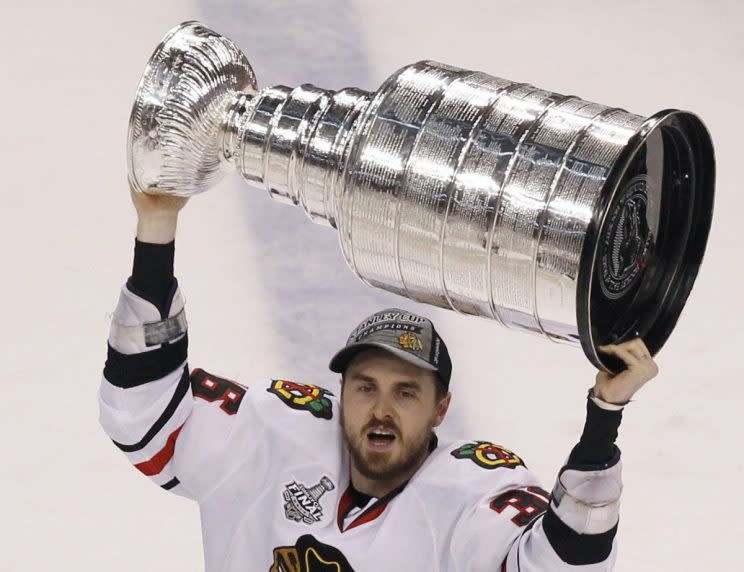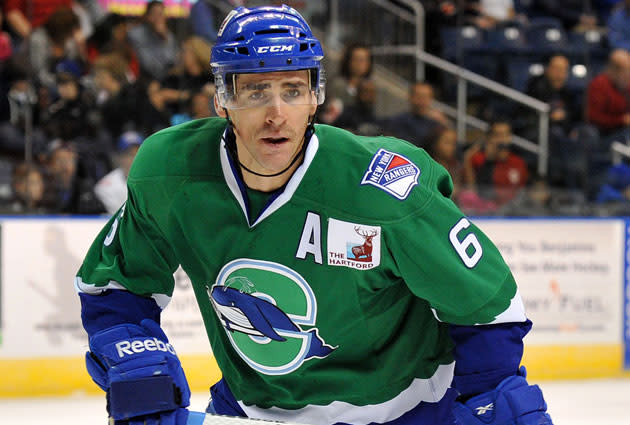Why won’t the NHL close Coyotes’ salary cap loophole?

What if I told you that your team could have two Hall of Famers and a former Stanley Cup champion for $1.675 million in total combined salary?
Granted, they have a combined cap hit of nearly $18 million, but that’s OK: Your team is basically laying on the salary cap floor, staring at the ceiling.
OK, you got me: There’s a slight catch.
One of the players is in the KHL. One of the players has a back injury so chronic that he might not play again. Oh, and one of the players is retired-save-for-the-paperwork, and in a feat of utter hilarity has an active contract as a player, a job with the League office and a Hall of Fame plaque. Which is a neat trick.
Now, would that be something that might interest you?
[Yahoo Sports Fantasy Hockey: Sign up and join a league today!]
Obviously, if you’re John Chayka, boy wonder general manager of the Arizona Coyotes, the answer is a resounding “yes.” Chris Pronger, Pavel Datsyuk and Dave Bolland are all on the cap for this season – Pronger and Datsyuk for one more year; Bolland, acquired in a trade with the Florida Panthers and hardly even mentioned in the Coyotes’ press release regarding that trade, is signed through 2019.
(In fairness, Pronger was former GM Don Maloney’s acquisition, but one wonders if that was Chayka influenced, as he had just arrived on the scene.)
What’s great about Chayka is that he’s managed to turn what might otherwise be his team’s plight – low payroll, lotsa cap space – into an ingenious way to spend to the cap without spending to the cap, and spend to the cap while acquiring young players instead of unrestricted free-agent bloat.
From Craig Morgan at Today’s Slapshot:
“Other teams have spent to the cap and they’ve acquired assets through free agency,” Chayka said. “We’re spending to the cap and we’re acquiring young players like Jakob Chychrun and Lawson Crouse that we feel can be core pieces. That’s what we’re after. As this stage of our organization right now we’re still trying to collect and identify and develop core pieces.
“There is the short-term loss of cap space and (assistant GM) Chris O’Hearn’s job gets a little more difficult, but otherwise not a whole lot of blood shed in that sense and we just continue to move forward with a good group of young players that are cost-controlled for a while so the cap space issue is really irrelevant.”
We’ve seen dead cap space traded before, but it’s usually in a “problem for problem” sense rather than what the Coyotes have done. Like the infamous David Clarkson for Nathan Horton trade, a small miracle between the Toronto Maple Leafs and Columbus Blue Jackets that Ken Campbell nonetheless called “legal circumvention of the salary cap,” which are words that don’t really go together. It was more like “exploiting a loophole.”
Now, “loophole” typically indicates something in a restrictive policy that’s been manipulated and will eventually be closed. Acquiring oodles of dead cap space would seem like one, in the sense that it’s allowing another team is violate the “spirit” of the salary cap, in that they’re making bad contracts go away rather than wearing them like an anchor of shame for their duration.
So are the Coyotes exploiting a loophole that will eventually be closed?
NHL deputy commissioner Bill Daly was asked that by Morgan, and said:
“I would say that it’s a matter that we monitor, like all other areas of the CBA (collective bargaining agreement), and if we believe it starts to be abused in a way that is inconsistent with how the system is designed to work, at that point, we would try to correct it in collective bargaining with the union,” Daly said. “I would say we aren’t at that point on this issue — we do not view it as the loophole that some describe it as.”
He went on to say that since Bolland wants to play again, his contract isn’t in the same category as Pronger’s as far as dead cap space. Sure.
Look, it’s a loophole. A glorious one. And it’s actually a loophole we’d be surprised if the NHL and the NHLPA eventually closes, because it’s a mutually beneficial one.
Let’s take it all the way back to 2011. Katy Perry beat Adele for video of the year. Donald Trump was simply a guest at the White House Correspondents’ Dinner. And Wade Redden was buried in the minor leagues.

The New York Rangers had sent an ineffective Redden to the AHL to get rid of his contract from their salary cap. He made $6.5 million against that cap, and the Rangers were content to let him twist on the vine in the minors. Had he been called up through re-entry waivers and another team claimed him for half that hit, the Rangers would have then been on the hook for the other half of dead cap space. So they kept him in the AHL. Just like the Columbus Blue Jackets did with Mike Commodore, the Edmonton Oilers did with Sheldon Souray, and so on.
Now, this mechanism was in place for teams to rid themselves of toxic contracts. And it was a complete joke: There was no penalty to those teams for making these terrible personnel decisions. Other teams were rightfully outraged. Other players, seeing their peers stuck in the sticks for the sin of signing a contract in a cap system, were rightfully outraged.
So it was remedied in the 2013 CBA: Buried players’ salaries now counted against the cap; new buyout rules made it easier to let players out of bad contracts; and, finally, having the ability to retain salary in a trade made transactions with other teams more fluid.
The basic lesson here is that there are two kinds of CBA loopholes:
The ones that allow single teams to exploit the salary cap for their own benefit and no one else’s. These are loopholes that must be closed and these are teams that must be punished.
The ones that allow multiple teams to exploit the salary cap for their own benefit. These are loopholes that will probably remain open because they help both teams, and yet one team still gets punished in the process.
So Chris Pronger costs Nicklas Grossmann and taking on a Sam Gagner contract the Coyotes might have otherwise bought out. Pavel Datsyuk costs four draft spots and taking on Joe Vitale’s contract. And Dave Bolland, most infamously, costs Lawson Crouse.
When you look at these moves, and others like them, the argument can be made that they’re “inconsistent with how the system is designed to work.”
Take away Datsyuk ($7.5M), Pronger ($4.941M) and Bolland ($5.5M), and you’re taking nearly $18 million off the Coyotes’ cap of $70.66 million. The cap floor is $54 million. No doubt, they’re still clear it with another three contracts on the books. But as of now, they’re over the salary cap floor because of dead cap space (or in Bolland’s case, cap space dedicated to a player who’s likely not playing this season).
So it benefits them, as it benefitted the Detroit Red Wings, Philadelphia Flyers and Florida Panthers. And as we debate the merits of the salary cap, we come back to one basic, underlying philosophy of any salary cap system: Ensuring competitive balance.
Ensuring that, despite economic disparity and competitive disadvantages, everyone has a chance to be a winner.
In exploiting this loophole, they can be.
—
Greg Wyshynski is a writer for Yahoo Sports. Contact him at puckdaddyblog@yahoo.com or find him on Twitter. His book, TAKE YOUR EYE OFF THE PUCK, is available on Amazon and wherever books are sold.

 Yahoo Sports
Yahoo Sports 


